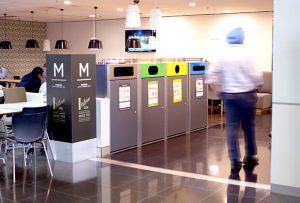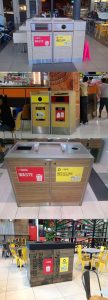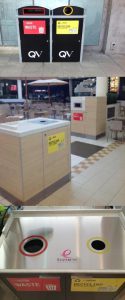
October 21, 2013
Food Court Recycling Programs – What To Consider…
Waste diversion programs in food courts is becoming increasingly common, driven by public demand for better recycling facilities, and the business benefits of sustainable work practice, both in terms of optimised waste costs, and branding. However the high volumes of largely transient visitors to food courts which amplify these drivers, actually propose unique challenges to ensuring a recycling program is successful.
Our team recently partnered with a national consultancy firm, Waste Audit Consultancy Services, on a program to review the food court waste practice across multiple centres of a national shopping centre organisation. The aim was to implement best practice waste diversion, whilst leveraging the existing assets of each centre where possible. Below the team share their key considerations for Food Court Recycling.
BUILT FOR PURPOSE SOLUTIONS SIMPLIFY RECYCLING

In busy food courts, built for purpose waste stations which integrate best practice features are even more important as the ability to educate is limited. Effective signs, modified apertures and Australian Standard colours are essential to ensure that recycling programs can be maintained even after the initial education phase finishes.
Essentially everything must be focused on making it easiest to recycle correctly!
WASTE STREAMS
The waste stream goals need to be carefully considered. Whilst organic food waste is often a large proportion of the waste, clean diversion of food waste is notoriously difficult. To establish a successful organics program, additional steps such as the shift by food retailer to Australian Certified compostable packaging is often required.
As a result many food courts are focused on plastic recyclables in the initial phase of their resource recovery program. Once established and working effectively, it can be easier to then add other more challenging waste stream such as organics, as users and impacted businesses are more engaged and aware of the benefits of recycling.
INVESTMENT IN EXISTING INFRASTRUCTURE
Some organisations perceive their existing investment in waste infrastructure as a blocker to implementing a recycling program. However with the right advice and modifications, retrofit solutions can work as effectively as new dual stream stations.
It is important however to ensure units are located and adapted to optimise convenience, and that the identifiable change is enough to prompt users to assess their waste disposal. Simply placing a recycling sign on a bin that users have used for landfill waste can sometimes have little impact and the resulting contaminated waste is difficult to recycle.
CONVENIENCE FOR CLEANERS

Often the focus is on users, but it’s essential to ensure that recycling programs also carefully consider the impact on the cleaners who need to manage the waste streams. If cleaners are not engaged and bins fill up to capacity, the benefits achieved in diverting waste from landfill are immediately lost.
It’s important to get the cleaning team engaged in the program, and understanding the environmental and business benefits of the program. Often they will be the public face of the program, answering questions.
In addition, waste stations must be durable and easy to access so that, even in the middle of the hectic lunchtime rush, bins can be easily emptied or changed in the crowds. Waste stations must also be attractive and easy to keep clean so that the team can take pride in their appearance.
For more information about unfolding the potential of Custom Design, or to discuss your unique waste needs, contact our team.